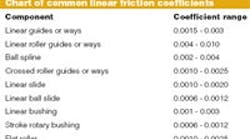As bearing balls roll in races, plain bearings ride over shafts, rollers glide along tracks, and belts wrap on pulleys, each loses energy through friction. The losses show up as either heat or surface wear, both of which damage components.
Research indicates that the roughness of sliding surfaces is not the main cause of friction, rather, the culprit is bonding. As mating surfaces slide across the other, the first layers of atoms form a bond that's almost as strong as that holding the individual solid structures together. Such adhesion accounts for more than 90% of the friction between sliding objects. The other 10% may come from plowing, where a hard surface digs grooves as its slides against a soft surface, or elastic hysteresis, where elastic compression and then partial relaxation consumes energy.
Lubricants reduce friction, but not merely by separating rough surfaces as once thought. Their bonds at the atomic level are just easier to break than other materials.
Friction is classed as either rolling or static, also known as breakaway. Rolling friction is the force needed to operate a component at a constant rate of travel. It's calculated as Pf = P x Fr
where Pf = frictional resistance, P = resultant of externally applied loads, and Fr = coefficient of rolling friction.
Static friction is the force needed to initiate movement and is calculated using the above formula, but substituting the coefficient of rolling friction with the coefficient of static friction. These numbers are available from component manufacturers.
Questions & answers
Q. How can I tell if a lubricant is worn out and no longer doing its job?
A: Even though manufacturers publish suggested lubrication intervals, operation conditions can change them. An easy way is to check the operating temperature of the lubricated part. As friction increases, so does the lubricant temperature, and therefore that of the part. More sophisticated methods include monitoring changes in energy consumption and vibration testing. Oil analysis, where you send a sample to a lab, is another method. For grease, you can test for apparent dynamic viscosity, wear particles, and water contamination.
Q: I'm still seeing too much friction in my linear guide system, even after relubrication. Any suggestions?
A: Did you include the sliding friction of the seals in your friction calculations? Seal resistance is often overlooked. It's not related to the load on the component, but to the efficiency of dust prevention.
Q: Is friction ever good?
A: It's what makes V-belt drives work.

